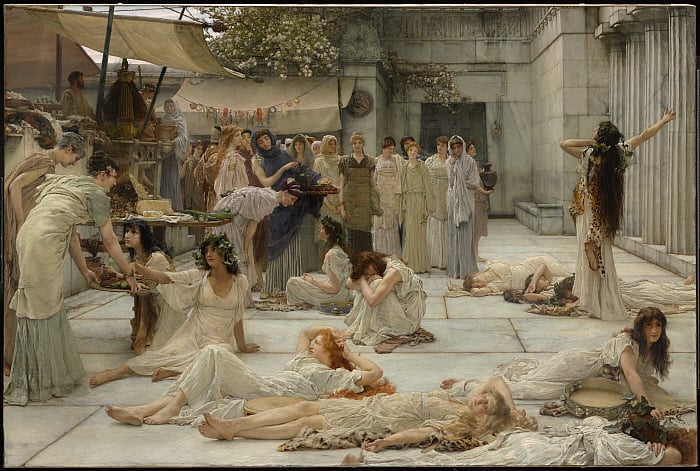The Women of Amphissa (1887) by Sir Lawrence Alma-Tadema is a stunning portrayal of charity and protection set against the backdrop of ancient Greece. This painting captures a poignant historical moment recorded by the Greek historian Plutarch, showcasing Alma-Tadema’s extraordinary skill in blending historical accuracy with emotional depth. The scene not only reflects a dramatic event from the past but also conveys a timeless moral lesson on compassion and selflessness, aimed at Alma-Tadema’s Victorian audience.
The Story Behind the Painting
The painting depicts an event from the Third Sacred War in ancient Greece. A group of women, followers of Bacchus (the god of wine), wandered into the marketplace of Amphissa, Greece, after a night of frenzied ritual dancing. At the time, Amphissa and Phocis were embroiled in conflict, yet the women of Amphissa chose to offer care and shelter to these Bacchantes. Despite the war raging around them and their differences with these women, the women of Amphissa extended a remarkable act of compassion by providing food, wine, and protection to the Bacchantes, their rivals from Phocis. This gesture ensured that the weary followers of Bacchus were safe from the potential harm of the soldiers, highlighting the women’s moral fortitude and humanity in the face of conflict. It serves as a powerful reminder of the strength found in kindness, even during times of war and division.
Hidden Details and Symbolism
Alma-Tadema’s meticulous attention to detail breathes life into this historical moment. The painting is filled with intricate elements—from the carefully rendered hairstyles and garments of the women to the delicate flowers and architectural details. The Bacchantes are shown in various states of exhaustion, their limbs sprawled across the stone pavement, while the women of Amphissa surround them, offering assistance. The shades of white used for the Bacchantes’ garments symbolize peace, purity, and vulnerability, reinforcing the theme of benevolence in the face of adversity.
The juxtaposition of the strong, protective women with the robust classical architecture of the marketplace underscores their role as guardians, standing firm amidst chaos. The marble columns, friezes, and the blooming cherry blossoms in the background enhance the tranquil yet purposeful atmosphere, blending the serenity of nature with the moral gravity of the moment.
Why the Painting Matters
The Women of Amphissa is significant not only for its technical brilliance but also for its thematic depth. The painting reflects Alma-Tadema’s commitment to showcasing femininity, protection, and charity, themes that were particularly resonant in Victorian society. By presenting a story of women who, despite being enemies in a political sense, acted with compassion toward their rivals, Alma-Tadema emphasized the importance of moral virtue in times of conflict.
This work was celebrated for its blend of historical storytelling and artistic achievement. In 1889, it won the Gold Medal of Honor at the Exposition Universelle in Paris, cementing Alma-Tadema’s status as one of the leading artists of the time. The painting not only portrays a moment in classical antiquity but also speaks to universal themes of humanity that transcended its historical context, offering valuable lessons for Alma-Tadema’s contemporaries.
Conclusion
The Women of Amphissa remains a masterpiece of Victorian-era history painting, one that continues to captivate with its emotional depth and historical insight. Through Alma-Tadema’s masterful technique and narrative, the painting presents a timeless message of compassion and protection, elevating the virtues of charity and care above the divisions of war and conflict. In this way, The Women of Amphissa endures as both a historical artifact and a moral lesson, offering viewers a glimpse into a past where humanity triumphed over enmity, and the power of charity transcended all boundaries.

Comments
Post a Comment